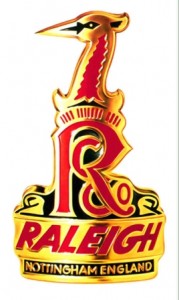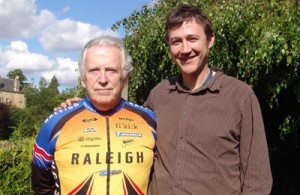
Raleigh logo at wikipedia.
Raleigh is the third stop on our Sillitoe Trail project for The Space and I’m delighted with how it’s turned out. I commissioned Pete Davis to talk to five former Raleigh workers so that we could build up an oral history of life working for the cycle manufacturer who celebrated their 125th anniversary this year. The rationale behind this was twofold: Firstly, oral histories gives our project greater diversity of content and so enable Saturday Night and Sunday Morning to be understood through a new prism and secondly, the testimonies enable us to compare the fictional portrayal of Arthur Seaton’s workplace with that of actual workers. Given that every member of Alan Sillitoe’s family worked at Raleigh I wouldn’t expect any inaccuracies.
Pete Davis is a local storyteller who has done this kind of work countless times and so was perfect for the role. A former fireman who himself worked at Raleigh (where he met his wife Sue) and a keen cyclist (his Raleigh bike has his name on it) he relished the role and was a consummate professional. When Pete records testimonies he writes them up and then sends copies off to the interviewees to sign off. The only real concern I had here was that some testimonies named specific people (sleazy bosses, workmates who drank on the job and various accounts of nepotism involving foreman). I removed these names to avoid being sued and because I didn’t want anything to be perceived as a personal attack. Pulling all of this content together was a short film from the British Council called How a Bicycle is Made which I was made aware of thanks to Andy Barrett, one of my mentors.
 Getting the testimonies in early was a massive help as it quickly became apparent that there were some recurring themes– such as the slow eroding away of the Sturmey-Archer site and how disappointed workers were to be laid off or see parts imported. To balance this out I got two additional testimonies from management. Ann Hodkinson was a former team manager who I found particularly fascinating as in addition to being a lesbian (imagine controlling all of those men) she couldn’t read or write. This showed that all promotions weren’t down to nepotism as well as bringing in a female voice. The other was with Managing Director John MacNaughtan, who was able to give context to why parts were shipped in from abroad and how the manufacturing industry had to adapt to various changes in the global economy. If there’s one thing you quickly learn working with the BBC it’s trying to strike a balance and this is definitely one area in which my writing has improved.
Getting the testimonies in early was a massive help as it quickly became apparent that there were some recurring themes– such as the slow eroding away of the Sturmey-Archer site and how disappointed workers were to be laid off or see parts imported. To balance this out I got two additional testimonies from management. Ann Hodkinson was a former team manager who I found particularly fascinating as in addition to being a lesbian (imagine controlling all of those men) she couldn’t read or write. This showed that all promotions weren’t down to nepotism as well as bringing in a female voice. The other was with Managing Director John MacNaughtan, who was able to give context to why parts were shipped in from abroad and how the manufacturing industry had to adapt to various changes in the global economy. If there’s one thing you quickly learn working with the BBC it’s trying to strike a balance and this is definitely one area in which my writing has improved.
Other articles included an introduction to Raleigh which was an excuse to celebrate factory workers up and down the country, the last day at the Sturmey-Archer site by Mark Patterson and a comparison of Saturday Night and Sunday Morning with Ben Hamper’s Rivethead, who worked on the production line for G.M. Motors.
My only disappointment is that all of the testimonies have been collated into one file which is far too text heavy. This dilutes the individual voices and I suspect may be a deterrent to your more casual visitor. Including more images would be one way of offsetting the text but unfortunately any images embedded in the text are far too small as it is, which is a pity given Paul Fillingham’s beautiful designs. But these things aside, I think we’ve done an excellent job in accurately representing factory life. Judge for yourself on The Space


